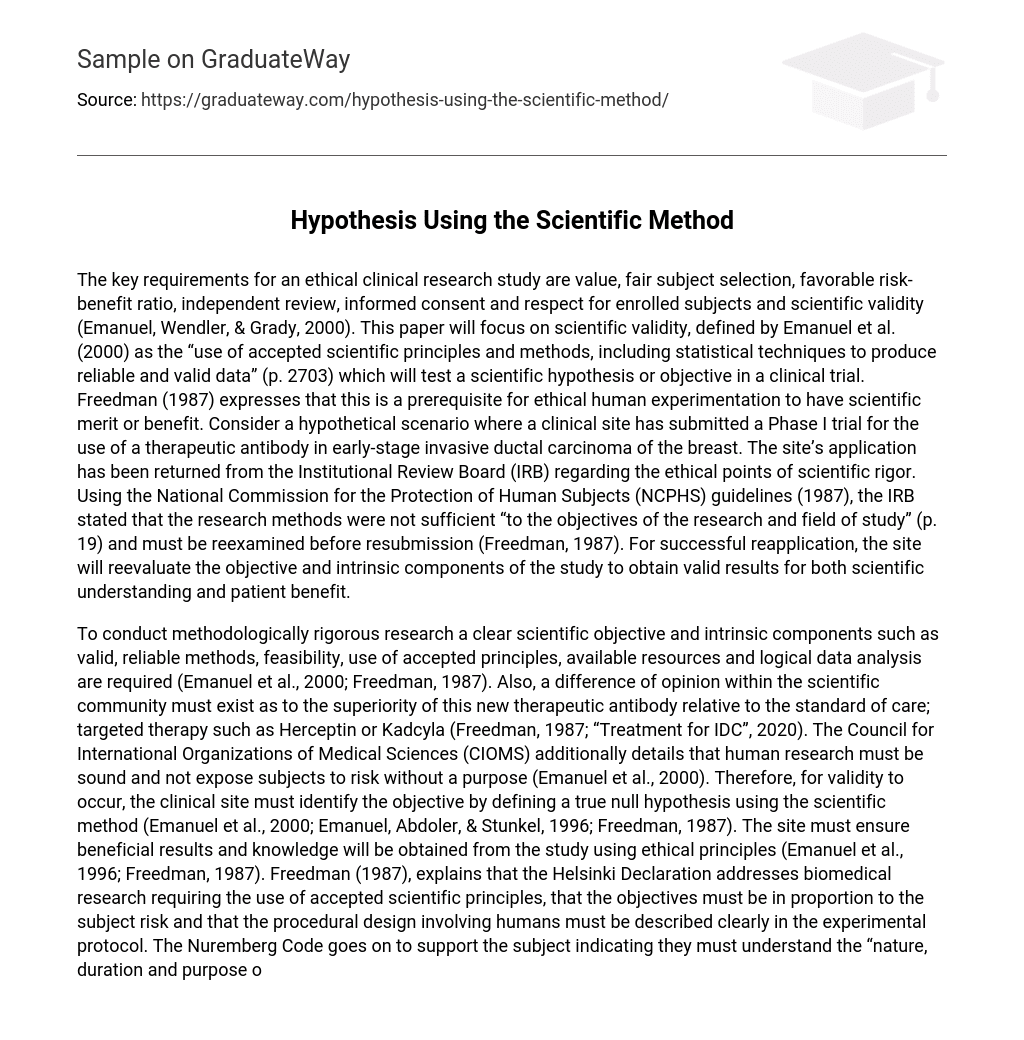The key requirements for an ethical clinical research study are value, fair subject selection, favorable risk-benefit ratio, independent review, informed consent and respect for enrolled subjects and scientific validity (Emanuel, Wendler, & Grady, 2000). This paper will focus on scientific validity, defined by Emanuel et al. (2000) as the “use of accepted scientific principles and methods, including statistical techniques to produce reliable and valid data” (p. 2703) which will test a scientific hypothesis or objective in a clinical trial. Freedman (1987) expresses that this is a prerequisite for ethical human experimentation to have scientific merit or benefit. Consider a hypothetical scenario where a clinical site has submitted a Phase I trial for the use of a therapeutic antibody in early-stage invasive ductal carcinoma of the breast. The site’s application has been returned from the Institutional Review Board (IRB) regarding the ethical points of scientific rigor. Using the National Commission for the Protection of Human Subjects (NCPHS) guidelines (1987), the IRB stated that the research methods were not sufficient “to the objectives of the research and field of study” (p. 19) and must be reexamined before resubmission (Freedman, 1987). For successful reapplication, the site will reevaluate the objective and intrinsic components of the study to obtain valid results for both scientific understanding and patient benefit.
To conduct methodologically rigorous research a clear scientific objective and intrinsic components such as valid, reliable methods, feasibility, use of accepted principles, available resources and logical data analysis are required (Emanuel et al., 2000; Freedman, 1987). Also, a difference of opinion within the scientific community must exist as to the superiority of this new therapeutic antibody relative to the standard of care; targeted therapy such as Herceptin or Kadcyla (Freedman, 1987; “Treatment for IDC”, 2020). The Council for International Organizations of Medical Sciences (CIOMS) additionally details that human research must be sound and not expose subjects to risk without a purpose (Emanuel et al., 2000). Therefore, for validity to occur, the clinical site must identify the objective by defining a true null hypothesis using the scientific method (Emanuel et al., 2000; Emanuel, Abdoler, & Stunkel, 1996; Freedman, 1987). The site must ensure beneficial results and knowledge will be obtained from the study using ethical principles (Emanuel et al., 1996; Freedman, 1987). Freedman (1987), explains that the Helsinki Declaration addresses biomedical research requiring the use of accepted scientific principles, that the objectives must be in proportion to the subject risk and that the procedural design involving humans must be described clearly in the experimental protocol. The Nuremberg Code goes on to support the subject indicating they must understand the “nature, duration and purpose of the experiment; method and means by which it is to be conducted” (Groden, M.A., p. 139, 2008*). In the second point of the Nuremberg Code, it expands on the validity requirement indicating beneficial results should be obtained and would be “unprocurable by other methods or means of study, and not random and unnecessary in nature” (Groden, 2008, p. 139). Altogether, these points reinforce avoidance of exploitation, generation of beneficial knowledge, justification of subject burden and lead into the justification of intrinsic components discussed below (Emanuel et al., 2000).
Once a clear objective is established it must then be tested using valid methods, reliable practices, feasibility and use of accepted principles falling in line with ethical guidelines. As detailed in The Belmont Report’s beneficence, justice and respect for persons for the research to be valid it must be supported by technical expertise, statistical, disease condition and population knowledge to effectively facilitate successful evaluation of study feasibility (Al Tajir, 2018; Emanuel et al., 2000; Freedman, 1987). The research must acknowledge and correct bias, address questions or statistical valuations, ensure appropriate sample size, and define critical endpoints with the subject’s best interests in mind to ensure the generation of ethical and valid data (Emanuel et al., 2000). These ethical considerations are directly addressed within the Declaration of Helsinki (Al Tajir, 2018). Once a valid method is developed, the clinical site must ensure that it is implemented with the precondition being the implementation of ethical research that will ensure the care, accuracy and optimal resource use to acquire interpretable data (Emanuel et al., 2000). Therefore, the IRB evaluates the research methods proposed, ensures that they support the objectives and field of study according to the guidelines set out by NCPHS (Freedman, 1987). The clinical site must ensure the study objective is stated clearly, that all intrinsic steps support the objective, and that it is conducted using available ethical guidelines.
What does this all mean for daily clinical practice? The investigators and staff must realize that any deficiencies along the path will question the study’s validity. Such aspects as insufficient size, skewed or poorly controlled samples that will directly affect statistical significance or a study focus that is not aligned with the objective can be problematic to achieving ethical validity (Freedman, 1987). Even once the objective has been defined, protocol adherence is important to obtain valid and interpretable data. Staff should have scientific expertise in each of the areas examined, but most importantly open patient communication and transparency. Even with a well-defined protocol and execution, the most important parameter is to ensure that the application addresses both ethical and scientific points to obtain scientifically valid data. Besides, clinicians who are investigators must keep in mind that they have an active interest in a study and a conflict of interest could occur if the research takes priority over the health and safety of their patients. This should be considered during enrollment, throughout the study, and at trial completion (American Thoracic, 2004). The ethical components of subject safety, rights and privacy will always be primary. These will directly tie into scientific validity and must be considered during planning, execution, and dissemination of trial results (Al Tajir, 2018).





